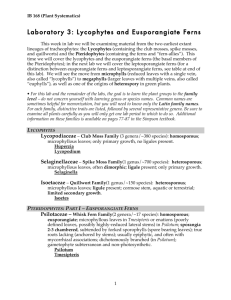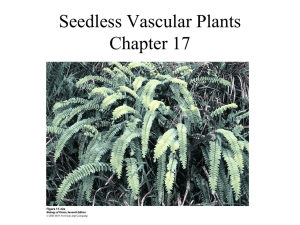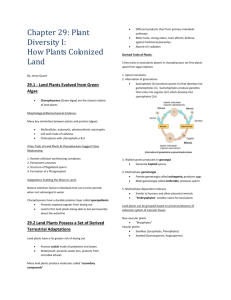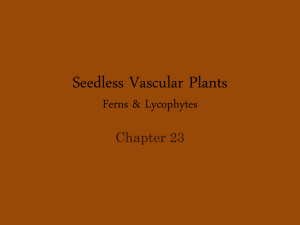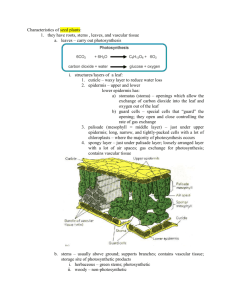ch21
advertisement
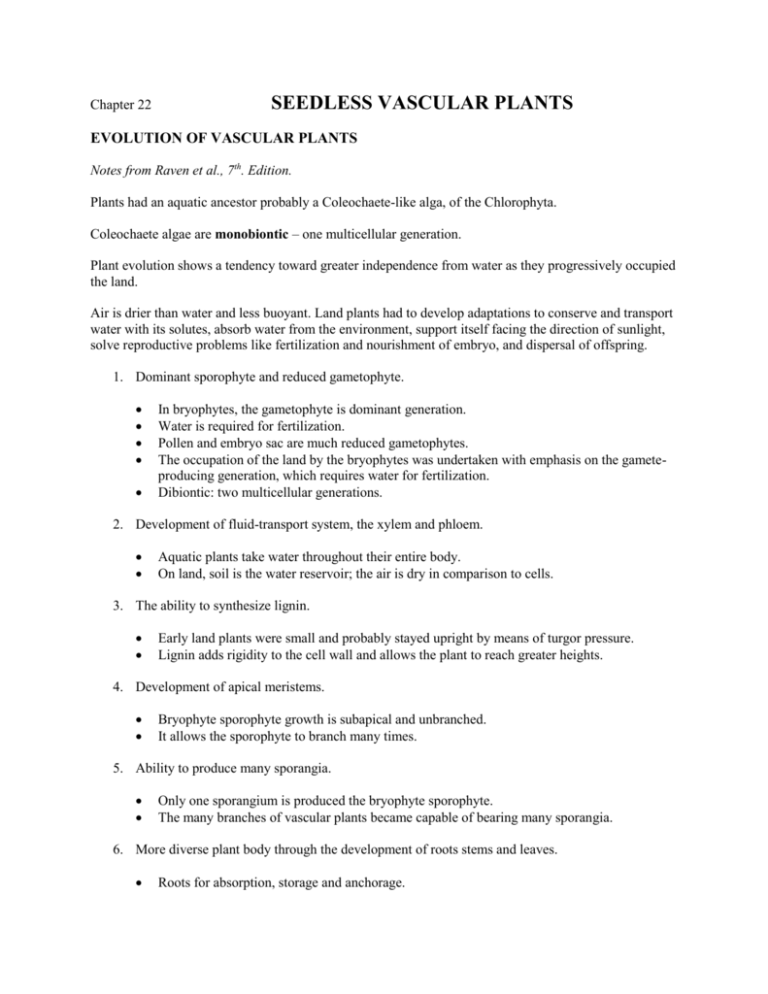
Chapter 22 SEEDLESS VASCULAR PLANTS EVOLUTION OF VASCULAR PLANTS Notes from Raven et al., 7th. Edition. Plants had an aquatic ancestor probably a Coleochaete-like alga, of the Chlorophyta. Coleochaete algae are monobiontic – one multicellular generation. Plant evolution shows a tendency toward greater independence from water as they progressively occupied the land. Air is drier than water and less buoyant. Land plants had to develop adaptations to conserve and transport water with its solutes, absorb water from the environment, support itself facing the direction of sunlight, solve reproductive problems like fertilization and nourishment of embryo, and dispersal of offspring. 1. Dominant sporophyte and reduced gametophyte. In bryophytes, the gametophyte is dominant generation. Water is required for fertilization. Pollen and embryo sac are much reduced gametophytes. The occupation of the land by the bryophytes was undertaken with emphasis on the gameteproducing generation, which requires water for fertilization. Dibiontic: two multicellular generations. 2. Development of fluid-transport system, the xylem and phloem. Aquatic plants take water throughout their entire body. On land, soil is the water reservoir; the air is dry in comparison to cells. 3. The ability to synthesize lignin. Early land plants were small and probably stayed upright by means of turgor pressure. Lignin adds rigidity to the cell wall and allows the plant to reach greater heights. 4. Development of apical meristems. Bryophyte sporophyte growth is subapical and unbranched. It allows the sporophyte to branch many times. 5. Ability to produce many sporangia. Only one sporangium is produced the bryophyte sporophyte. The many branches of vascular plants became capable of bearing many sporangia. 6. More diverse plant body through the development of roots stems and leaves. Roots for absorption, storage and anchorage. Stems for support above ground, transport and growth toward the light. Leaves for photosynthesis. 7. Evolution of seeds. Provides the embryo with food and protection. Dispersal of the species to new locations. HYPOTHESES ABOUT THE ORIGIN OF THE ALTERNATION OF GENERATIONS Notes from Mauseth. INTERPOLATION THEORY This theory presumes that the earliest land plants did not have a sporophyte generation; the zygote germinated by meiosis that produced haploid spores that grew into new haploid gametophytes. A small sporophyte came into existence when a zygote germinated mitotically instead of meiotically. The sporophyte generations would have gradually evolved in complexity while the gametophyte generation remained small. A sporophyte generation was inserted (interpolated) into the monobiontic life cycle. Some bryophytes may represent an intermediate stage in the progression from green algae to vascular plants. Riccia and Ricciocarpus have simple, almost alga-like gametophyte, and their sporophytes consist of just a small globose sporangium with not foot or seta. The zygote undergoes several mitotic divisions and then some cells undergo meiosis. Speculation: the sporophyte then evolved more complex with a foot and seta, and later developed an apical meristem to branch and live free of the gametophyte. TRANSFORMATION THEORY After the dibiontic life cycle originated, both gametophyte and sporophyte became larger, more complex, and vascularized, in a life cycle with an alternation of isomorphic generations. No living plants have generations that are alike but many algae do and so do some fossil plants The transformation theory postulates that plants evolved into two clades: 1. Nonvascular plants in which the sporophyte became much simpler and dependent on the gametophytes 2. Vascular plants in which sporophytes became increasingly elaborate whereas gametophytes became reduced. EARLY VASCULAR PLANTS Notes from Raven et al. There are three divisions of extinct seedless vascular plants: Rhyniophyta, Zosterophyllophyta and Trimerophytophyta. The genera Rhynia, Zosterophyllum and Trimerophyton are members of these phyla. The earliest known go back about 425 million years ago and most went extinct by the end of the Devonian about 370 million years ago. These three groups were the dominant vegetation from the mid-Silurian to the mid-Devonian, 425 to 370 million years ago. For the most part they were relatively simple plants 18 in to 36 inches tall. They had the following characteristics: 1. Naked photosynthetic stems 2. Terminal sporangia (some lateral) 3. No roots or leaves 4. They were all homosporous 5. They had protosteles Pteridophytes, lycophytes and progymnosperms are more complex groups that were dominant from the Late Devonian through the Carboniferous, from about 370 to 290 million years ago. Seed plants arose starting in the Late Devonian period, about 380 million years ago, and evolved many new lines by the Permian (290-248 million years ago). Gymnosperms dominated the land floras throughout the Mesozoic until about 100 million years ago. Angiosperms appeared in the fossil record about 125 million years ago. It became the dominant group about 30 – 40 million years ago, and has remained so until the present. XYLEM STRUCTURE OF EARLY VASCULAR PLANTS. Early vascular plants had two types of xylem organization: endarch protostele and exarch protostele. The protostele consists of a solid, central mass of vascular tissue with no pith. In endarch protostele the protoxylem is located in the center of the protostele, and the metaxylem surrounds it. In the exarch protostele, the metaxylem is located in the center and the protoxylem grouped into several clusters around the metaxylem. Siphonostele evolved after the protostele. Siphonostele has a central pith surrounded by xylem. Xylem consisted of tracheids. Around the xylem there was a layer of phloem-like cells and then a parenchymatous cortex and epidermis. Division Rhyniophyta The Rhyniophytes are a group of early land plants originally described from the Rhynie Chert, Scotland. The earliest vascular plant fossil belongs to the genus Cooksonia. It became extinct in the mid-Devonian about 380 million years ago. Plants with these characteristics are called rhyniophytes. Seedless; produced spores. Dichotomous branching. Terminal sporangia. Homosporous. Plant body was not differentiated into roots, stems and leaves. Epidermis with a cuticle, cortex of parenchyma cells, and protostele. Underground rhizome with rhizoids. Protostele consisting of a core of xylem surrounded by one or two layers of phloem cells. Some had conducting cells similar to hydroids rather tracheids; they are called protracheophytes. There is evidence of isomorphic alternation of generations. Examples: Rhynia, Cooksonia, Aglaophyton. Rhynia appeared in the mid-Silurian record about 425 million years ago. Fig. 17-12 in Raven et al. and Fig. 21.5 in Mauseth, is the reconstruction of the plant Aglaophyton major by D. S. Edwards (1986). The original name, given by Kidson and Lang, was Rhynia major, but Edwards showed that the central strand did not consist of tracheids with secondary wall thickenings. So the plant had to be transferred to another genus. In fact Aglaophyton cannot be reckoned to belong to the Tracheophyta and does have affinities to the mosses. Aglaophyton major may represent an intermediate stage in the evolution of vascular plant known as protracheophytes. The transverse section of the stem resembles that of Rhynia gwynne-vaughanii, but it is larger. The size of the plant is estimated at a maximum of 18 cms. The stem diameter is between 1.5 and 6 mms. In the same rocks where Rhynia and Aglaophyton were found, Lynophyton and Sciadophyton were also found. These last two plants are gametophytes and not sporophytes. They had flattened stem apices with archegonia and antheridia, but no sporangia. Because Sciadophyton occurs together with Rhynia, they may represent two generations of the s same species. Horneophyton is another fossil with naked axes that branch dichotomously. They had stomata and terminal sporangia. Phylum Zosterophyllophyta Notes from Raven et al. Fossils of zosterophylls have been found in rocks from the Early and Middle Devonian, 408 to 370 million years ago. Aerial stems were covered with cuticle and had stomata only on the upper branches. They were approximately 15 cm high. Protoxylem consisted of tracheids with annular or scalariform secondary walls. Zosterophyllum dichotomously branched, but frequently lateral branches further differentiated into one axis that grew upward and another downward. The lower branch may have function as a root. Some Zosterophylls were naked or had small spine-like enations. The sporangia were globose or reniform and borne laterally on short stalks. Dehiscence of sporangia was across the top of the sporangium; in rhyniophytes, dehiscence was lateral on the sporangium. Zosterophylls were homosporous. Xylem matured from the periphery toward the center: centripetal differentiation also known as an exarch protostele. They are considered to be the ancestral group that gave rise to the Lycopods; the sporangia of both groups are borne laterally and are similar in shape, and the xylem in both groups differentiates centripetally. The sporangia of euphyllophytes (ferns, gymnosperms and angiosperms) are borne terminal on the axis. That indicates that Zosterophyllum with its lateral sporangia is probably not the ancestor of euphyllophytes but of lycophytes, which bear lateral sporangia. Other general of zosterophyllophytes showed significant morphological changes: enations with a vascular trace that ended at the base of the enation, trunk-like shoots bore smaller short lateral shoots. These are the morphological bases for producing cones and trunks. Phylum Trimerophytophyta Notes from Raven et al. This phylum probably evolved directly from the rhyniophytes. Trimerophytes were larger and more complex plants than the rhyniophytes or zosterophyllophytes. Trimerophytes appeared in the Early Devonian about 395 million years ago and had become extinct by the end of the mid Devonian, about 20 million years later – a relative short period of existence. They lacked leaves. Lateral branches forked dichotomously several times. They were homosporous. Some branches were vegetative while others bore elongated sporangia. Vascular strand was more massive than that of the rhyniophytes. The xylem differentiated centrifugally. Division Lycopodiophyta MORPHOLOGY There are about 15 genera of lycophytes and approximately 1200 living species. This evolutionary line extends back into the Devonian but was most prevalent in the wet swamps of the Carboniferous period. The earliest lycophytes were members of the general Depranophycus and Barawagnathia. They were similar to their ancestors the zosterophylls, but with the difference of having large, up to 4 cm long enations with a single well-developed trace of vascular tissue, called microphylls. Many extinct lycophytes such Lepidodendron, Sigillaria and Stigmaria had a vascular cambium and secondary growth with pith rays and elongated tracheids. Their cambium could not undergo radial longitudinal division; there fore, new fusiform initials could not be produced. As the wood grew to a larger circumference, cambial cells became increasingly wider tangentially and may have stretched so much that they could not function. No fossil has been found with wood more than about 10 cm thick. HETEROSPORY In many extinct and extant lycophytes, sporangia are clustered in “cones” or strobili (sing. strobilus) Some species became heterosporous producing megaspores and microspores. Spores of 2 types (plants heterosporous), megaspores (1--2--4), large; microspores numerous (hundreds), very small. Gametophytes unisexual: microgametophytes (males) and megagametophytes (females). Heterospory is a necessary condition for the evolution of seeds. In some the megaspore developed into a megagametophyte without enlarging: the megagametophyte existed completely within the wall of the original megaspore, which was up to 10 mm long. The megaspore of some species was retained within the sporophyll, protected by the thick wall of the sporangium. This is very similar to ovules and seeds. The sporangium dehisced and sperms could swim to the egg. EXTANT ORDERS AND GENERA Notes from Raven et al. Molecular and morphological evidence indicate that they split up into two evolutionary lines before 400 million years ago, in the Early – Mid Devonian. The lycophyte clade includes the modern lycophytes. The euphyllophytes clade includes whisk ferns, horsetails and seed plants. The extinct lycophytes include very large woody trees that did not survive in the drier climate at the end of and after the Carboniferous age. In the Carboniferous some lycophytes were forest-forming trees more than 35 meters tall. Woody lycophytes became extinct before the end of the Paleozoic era, 248 million years ago. The second and the surviving group of Lycopods are the small and herbaceous plants. Lycophyta remains became the largest coal deposits of all geologic time. Lycophyta are characterized by microphyllous leaves, a special spore producing body called a strobilus, the presence of true vascular stems, roots and leaves. There are three prominent orders of Lycophyta: Lycopodiales, or club mosses; Selaginellales, or spike mosses; Isoetales, or quillworts. Family Lycopodiaceae A family of about 400 species, mostly tropical. The taxonomic boundaries of the genera are not well understood and as many as 15 genera may eventually be recognized. Seven of these genera are represented in North America. Sporophyte with true leaves, stems and roots. Dichotomous branching rhizome from which aerial branches and roots arise. Stems and roots are protostelic or siphonostelic. Leaf gaps absent. Leaves are microphyllous and spirally arranged, sometimes opposite or whorled. Sporophylls, modified fertile microphylls, sometimes grouped into strobili (strobilus, cluster of overlapping non-photosynthetic sporophylls). In Huperzia and Phlegmariurus, the sporophylls are similar to ordinary microphylls and are interspersed among the sterile microphylls. One sporangium per sporophyll, near the base and on the adaxial side. Homosporous. Gametophyte bisexual, either green or subterranean, non-photosynthetic, mycorrhizal structures, depending on the genus. Gametangia, antheridia and archegonia, may require 6 to 15 years to mature. Self-fertilization is rare. Biflagellated sperm requires water to reach the archegonium. Family Selaginellaceae There are about 700 species in this family, most of them tropical. Selaginella is the only genus in the family. Plants herbaceous, annual or perennial, sometimes remaining green over winter. Stems leafy, branching dichotomously, regularly or irregularly forked or branched. Stems and roots protostelic (sometimes with many protosteles or meristeles), siphonostelic, or actinoplectostelic. Protostele held in place by trabeculae. Rhizophores (modified leafless shoots producing roots) present or absent, geotropic, borne on stems at branch forks, throughout, or confined to base of stems. Leaves microphylls, on 1 plant dimorphic or monomorphic, small, with adaxial ligule near base, single-veined, rarely veins forked. Strobili sometimes ill-defined, terminal, cylindrical, quadrangular, or flattened. Sporophylls (fertile leaves) monomorphic or adjacently different, slightly or highly differentiated from vegetative (sterile) leaves: microsoporophylls and megasporophylls. Sporophylls and microphylls with ligule. Sporangia short-stalked, solitary in axil of sporophylls, opening by distal slits. Spores of 2 types (plants heterosporous), megaspores (1--2--4), large; microspores numerous (hundreds), very small. Gametophytes unisexual. Gametophytes develop inside the spore wall: endosporic development. Microgametophyte lacks chlorophyll. At maturity, it consists of a single prothallial cell and an antheridium. Antheridium produces many of biflagellated sperms. Microspore wall ruptures to liberate the sperms. Megagametophyte multicellular. Megagametophyte protrudes through a rupture in the spore wall. Archegonia develop in the exposed area. Sperms require water to swim to the archegonia. The suspensor develops and pushes the developing embryo deep into the female gametophyte. Family Isoetaceae A family of one genus, Isoetes (ca. 150 spp.), found world-wide, especially in temperate areas. A second genus, Stylites, is sometimes recognized. Some authors put fossil representatives in the genus Isoetites, which is known from as early as the upper Triassic. Plants tufted, grass-like, perennial, evergreen aquatics to ephemeral terrestrials. Underground stem brown, cormlike, lobed. Roots arising along central groove separating each rootstock lobe, simple or dichotomously branched, containing eccentric vascular strand and surrounding lacuna. Leaves linear, simple, spirally or distichously arranged, dilated toward base, tapering to apex, covered with a cuticle, containing 4 transversely septate longitudinal lacunae, a central collateral vascular strand, and frequently several peripheral fibrous bundles. They lack stomata. Isoëtes has CAM photosynthesis. Absorbs carbon dioxide from the mud surrounding the roots. Each leaf is a potential sporophyll. Ligule inserted above sporangium on each sporophyll. Heterosporous (megaspores and microspores not alike). Megasporophylls and microsporophylls usually borne in alternating cycles; hardened scales and phyllopodia occasionally surround leaves. Sporangia solitary, adaxial, embedded in basal cavity of leaf, velum (thin flap extending downward over sporangium) partly to completely covering adaxial surface of sporangium. Megasporangium with several to hundreds of megaspores. Microsporangium with thousands of microspores. Megagametophytes white, endosporic, exposed when megaspore opens along proximal ridges; archegonia 1 to several, indicated by quartets of brownish neck cells. Microgametophytes 9-celled, endosporic, antheridium releasing 4 multitailed spermatozoids. CONVERGENT EVOLUTION WITH SEED PLANTS In both lines: Elaborate efficient leaves, wood, bark and roots evolved. Sporangia became separated from vegetative structures and grouped into strobili. Heterospory evolved. Endosporial development of the gametophyte. THE MEGAPHYLL LINE OF EVOLUTION: EUPHYLLOPHYTES Division Trimerophytophyta. A fossil phylum that seems to have evolved from rhyniophytes. It was proposed to include three genera: Trimerophyton, Psilophyton and Pertica. It might be the ancestor of ferns, progymnosperms and perhaps horsetails. They first appeared in the early Devonian about 395 m.y.a. and became extinct by the end of the mid Devonian, at about 370 m.y.a. Trimerophytes were very similar to rhyniophytes in that they lacked leaves and roots; most of the plant body consisted of a dichotomous branching stems that were photosynthetic throughout their length. They were also similar to rhyniophytes in being homosporous, having sporangia that dehisce laterally, Vascular tissue was present, forming a solid central bundle in the center of the stem, or protostele. Their protostele was more massive than that of rhyniophytes. They had a band of thick-cell-wall cells in the cortex. Xylem differentiated centrifugally like in rhyniophytes. Trimerophytes branched pseudomonopodially, that means that the branching was unequal, forming a main stem, or axis, with several smaller lateral branches. Rhyniophytes branched dichotomously: stems always branched into two equal branches. Lateral branches typically branched dichotomously, and were often shortened to form bushy "webs" of small, closely spaced branches. Some trimerophytes also bore enations on the main stems, giving them a superficially "thorny" appearance. Correlated with the pseudomonopodial growth habit and the numerous photosynthetic branches was an increase in the vigor and robustness of the plant. Trimerophytes bore sporangia at the tips of branches, like the rhyniophytes, but unlike the superficially similar zosterophylls from the same time period. The spindle-shaped sporangia produced only one type of spore: trimerophytes were homosporous. Spores released from the sporangia would have germinated into gametophytes, but no fossil trimerophytes gametophytes have been identified, and we do not know whether trimerophytes, like their later relatives the ferns, sphenopsids, and seed plants, had small, inconspicuous gametophytes. Trimerophytes varied in size from a few centimeters to nearly a meter tall; large trimerophytes were among the largest plants of the Early Devonian. ORIGIN OF THE MEGAPHYLL (EUPHYLLS) – TELOME THEORY Three distinct homoplastic (analogous) structures called leaves occur in plants: Leaves on gametophytes of nonvascular plants. Enations and microphylls in zosterophyllophytes and lycophytes. Megaphylls that evolved from a branch system and are present in all seed plants, ferns and equisetophytes. The megaphyll evolution is summarized in the Telome Theory. The twigs of the last dichotomy are called telomes. Beginning with a dichotomous branch, the megaphyll evolved following the steps listed below. This theory is based on the study of fossils made by Zimmermann in the 1930s. One branch overtops the other which remain small and lateral: overtopping. The lateral branch system becomes restricted in their branching to one plane: planation. The spaces between close branches developed a thin sheet of chlorophyll-containing cells: webbing. The euphyllophytes consists of two sister clades: monilophytes and lycophytes. Several current studies suggest that megaphyllous plants are united by three synapomorphies: 1. Roots have exarch xylem. 2. They have megaphyll. 3. They have a 30-kilobase inversion in the large single-copy region of their plastid DNA. MONILOPHYTES Many monilophytes are known as ferns (Leptosporangiate, Ophioglossales, Marattiales); others are known as fern allies (equisetophytes, Psilotales). The Division Arthrophyta consists of four Orders, three of which are extinct, and one extant, Order Equisetales. EQUISETOPHYTES ORDER EQUISETALES Notes based on Raven et al. Equisetophytes extend back to the Devonian and reached their maximum development in the Carboniferous (380-280 m.y.a.). A family of one extant genus, Equisetum (ca. 15 species), of nearly worldwide distribution in damp habitats such as riverbanks, lakeshores, and marshes. Michigan is a center of diversity for the genus with nine native species. They are known by their common name as horsetails or scouring rushes. The sporophyte of Equisetum is differentiated into an underground rhizome that bears adventitious roots and an upright, photosynthetic stem with whorls of microphylls.. Tough perennial herbs with jointed, ridged aerial stems with distinct nodes. Stems rough, accumulating silica and metals, and complex anatomically. True roots are present. The aerial stems contain a large central pith region, which in mature plants is hollow. This is the arrangement of a siphonostele. Surrounding the pith cavity are discrete bundles of vascular tissue. Some call this arrangement of discrete bundles around the pith a eustele, and not a siphonostele. The bundles contain both xylem and phloem, and are marked by the presence of large canals known as carinal canals (under the ridges), which also function in water conduction. The protoxylem is endarch. Xylem contains vessels, a rare occurrence outside angiosperms. External to the vascular bundles is another set of canals, the vallecular canals or cortical canals (under the valleys). These canals line up with the depressions between the ribs on the surface of the stem. Most fossil sphenophytes had very similar stem morphology. The cortex is composed of large cells, the outer ones chlorophyllous. The epidermis contains stomata and guard cells. Leaves are small, whorled, non-photosynthetic, fused together to various degrees and adpressed to the stem. Sporangia borne on peltate sphorangiophores aggregated into a strobilus. Strobili consist of tightly packed appendages called sporangiophores. Homosporous; spores with elaters. Gametophytes green, epigeal, bisexual or unisexual, male gametophytes smaller than female; with rhizoids. Archegonia develop before antheridia to increase the probability of cross-fertilization. Sperms are multiflagellated and require water to swim to the egg. Several eggs on a single gametophyte may be fertilized. The arthrophytes can be traced back to through the trimerophytes to the rhyniophytes. The Sphenophyllales and Calamitales had secondary growth but their fusiform initials could not undergo radial longitudinal division to produce more fusiform initials. FERNS The fossil record of ferns extends back into the Carboniferous There are five orders of ferns often recognized by pteridologists. Ophioglossales, Marattiales, Filicales, Marsileales and Salviniales. The Ophioglossales and Marattiales are eusporangiate. The other three are leptosporangiate. There are 12,000 species of ferns in the world. Most species are tropical. There are about 420 species of ferns in U.S.A. and Canada. Costa Rica has over 1,100 species. Philippines has over 960 species. Sporophyte is differentiated into true roots, stem (rhizome) and leaves (megaphylls). The stele varies from a protostele to a complex dictyostele. The xylem is composed of tracheids. Leaves or fronds develop in curled position at the apex of the rhizome (stem) and uncoil as they mature, a condition called circinate vernation. Leaves usually differentiated into stipe (petiole) and blade with a central rachis or vein. Leaf gaps are conspicuous. They are associated with leaf traces, the vein that goes into the petiole or stipe. Most ferns are homosporous; a few aquatic genera are heterosporous. Sporangia normally develop on the abaxial (dorsal, lower side) or on the margin of the leaf. Clusters of sporangia occur in most ferns and are called sori (sing. sorus). Gametophytes are inconspicuous and arise directly from spores. Gametophytes are bisexual in homosporous ferns and unisexual in heterosporous ferns. Sperms are flagellated and coiled. Sporangial development is important in the understanding of the evolutionary relationship of vascular plants. 1. The eusporangiate sporangium (eusporangia) has the sporangial wall developing from several superficial cells and the sporogenous tissue develops from internal cells of the sporophyll. The sporangial wall is several cells thick. The inner wall cells may be compressed and stretched so that the sporangial wall may appear to be made of a single layer of cells at maturity. The sporangia are large and contain a large number of spores. 2. The leptosporangiate sporangium (leptosporangia) develops entirely from the periclinal division of a single superficial cell. By a precise pattern of division a stalk and a globose capsule are formed. A nutritive tapetum develops inside the capsule. The inner mass of cells develops into spore mother cells that undergo meiosis. The remnant of the tapetum is deposited around the spores and gives them their characteristic ornamentation. The annulus is made of unevenly thickened cells. The number of spores produced is a multiple of 2 (between 16 and 512 in homosporous species). 3. Eusporangiate sporangium is characteristic of all vascular plants except the leptosporangiate ferns. There are five orders of ferns often recognized by pteridologists. Ophioglossales, Marattiales, Filicales, Marsileales and Salviniales. The Ophioglossales and Marattiales are eusporangiate. The other three are leptosporangiate. Psilotum and Tmesipteris It includes two living genera, Psilotum and Tmesipteris, from tropical and subtropical regions of the world. These plants are simplest vascular plants. Psilotum is built much like Rhynia and Aglaophyton and used to be grouped in the same clade. Psilotum is now known to be highly derived, a highly simplified fern. Sporophyte with a dichotomously branching aerial and subterranean stem system. True roots lacking. Underground stems with rhizoids and with a fungal association, an endomycorrhizal zygomycete. Aerial stems lacking leaves but with scale-like or larger leaf-like structures (enations) Gametophytes bisexual, subterranean, resembling a small piece of rhizome Gametophyte with a symbiotic fungus. Some have a vascular tissue The sperm is multiflagellated and requires water to swim to the archegonium. Homosporous Sporangia, a 2 or 3-chambered synangium, borne at the apex of small side-branches (appear to be arranged along the sides of the major stems of the plant--sporophyte) Sporophyte remains attached to the gametophyte in the early stages by a foot and derives nourishment from the gametophyte. THE TERM VASCULAR CRYPTOGAMS Traditionally the plants in this chapter have been referred as Vascular Cryptogams or Ferns and Fern Allies. These plants share two ancestral features (symplesiomorphies): 1. Because they lack seeds, their reproduction is “hidden” (crypto = hidden). 2. They have vascular tissue. Vascular cryptogams are NOT grouped together because ancestral characters are not used to show relationships between plants. To group the vascular cryptogams, monilophytes and lycophytes) only into a clade would leave the lignophytes out. The ancestor of the monilophytes is also the ancestor of the lignophytes. To leave lignophytes out would be to create a paraphyletic group, which is not correct.
